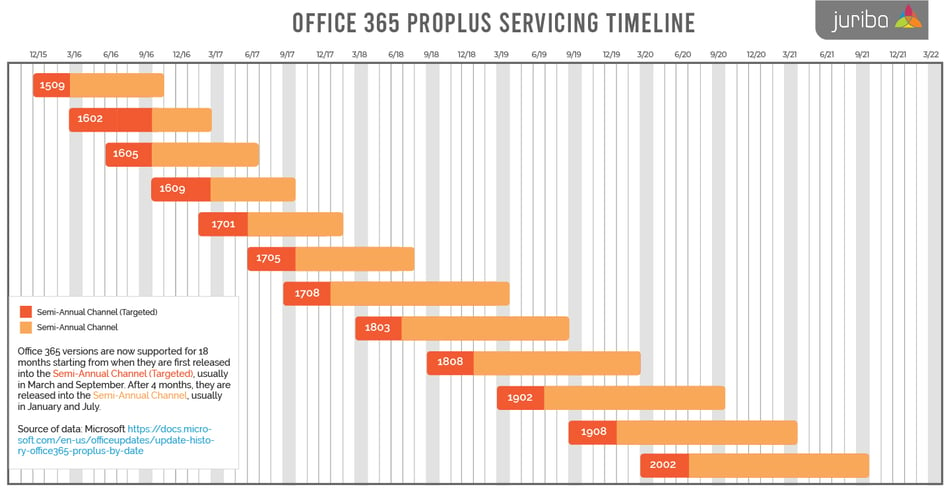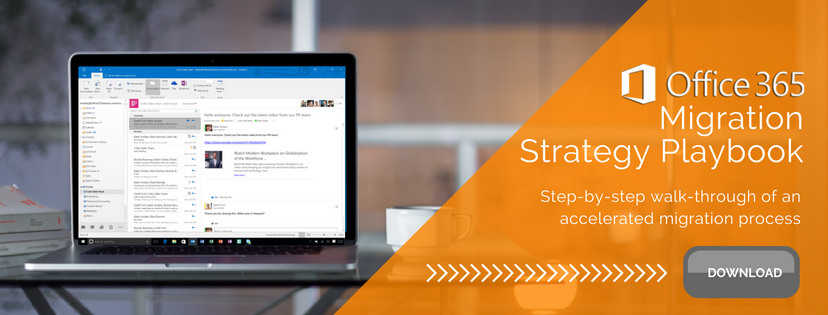Understanding The Office 365 Servicing Timeline (As of May 2021)
November 8th, 2017
9 min read
By Barry Angell
.jpg?width=1600&height=900&name=Understanding%20The%20Office%20365%20Servicing%20Timeline%20(As%20of%20May%202021).jpg)
NOTE: Since Office 365 has undergone significant changes by Microsoft in it's naming convention and update channels, we will no longer be updating this post, as we have created a new post detailing those changes, and that post will receive the updates for new releases and EOL dates.
However, this post will remain to keep a record of the historical information on Office 365.
On April 20th, 2017, Microsoft announced that it will make big changes regarding Office 365 ProPlus.
The first part of the announcement detailed new system requirements, such as the need for all Office 365 ProPlus and Office perpetual in mainstream support to be connected to Office 365 services by 2020. However, the second part of the announcement created a much bigger stir among IT professionals: Microsoft has aligned the Windows 10 release schedules and support lifecycles with those of Office 365 ProPlus because customers have "asked us to simplify the update process and to improve the coordination between Office and Windows."
In February of 2018, Microsoft also announced clarifications to the Office and Windows servicing position. The first is for users running ProPlus in a Windows 10 environment: ProPlus will not be supported on Windows 10 Semi-Annual Channel versions that are no longer being serviced. The second clarification, effective January 14, 2020, is that ProPlus will not be supported on the following versions of Windows: Windows 8.1 and older, Windows Server 2016 and older, and any Windows 10 LTSC release.
Even though your organization most likely has a subscription to Office 365 Enterprise E3 or E5, you should be familiar with the recently announced ProPlus update model. E3 and E5 include the on-premise version of the Microsoft Office Suite with the regular 10-year support agreement. However, Microsoft is making continuous updates to its Office suite — putting enterprises more and more behind the eight ball.
Since this elongated lifecycle won't be a sustainable support strategy going forward, especially for those using a combination of local installs and browser-based use, we believe these updates will eventually be carried through to other O365 versions. Therefore, you should start preparing now for what is sure to come in the next few years.
Update 2020: In April 2020, certain versions of Office 365 ProPlus are being renamed to Microsoft 365 Apps for enterprise. Please see this article and this one from Microsoft for more information on the change.

In September 2017, Microsoft implemented the following changes to the Office 365 ProPlus (from now on referred to as Office 365 only) update model:
- There will only be two updates per year. Microsoft is reducing the number of updates per year to two — targeted for March and September each year — to align with its new semi-annual channel model for Windows 10 and Office 365 ProPlus.
- Support timeline extends to 18 months after initial release. Microsoft will extend its support period for Office 365 ProPlus releases from 12 to 18 months to better accommodate the semi-annual channel cycles and allow IT pros to align deployment phases.
- SCCM and Windows Server support aligns as well. While the original April announcement only mentioned that the System Center Configuration Manager (SCCM) will also align its update model with that of Office 365 ProPlus and Windows 10, Microsoft announced in July that Windows Server will join the club as well — making it easier to test, deploy, and update all the products together.
Update: Microsoft announced on Sept. 6th, 2018 that the company is updating its Windows system requirements for Office 365 ProPlus and revising some of the announcements mentioned above. Office 365 ProPlus customers will continue to be supported on Windows 8.1 through January 2023 (end-of-support date) and on Windows Server 2016 until October 2025. In addition, Microsoft will continue to support Office 2016 connections with the Office 365 services through October 2023.
Basic Office 365 Update Model Terminology & Concept
Before we dive into the support timeline and update lifecycle, let's define the basic terms and talk about the general concept of the Office 365 update model.
What is Office 365 ProPlus?
The software giant offers four enterprise plans: Office ProPlus, E1, E3, and E5. One of the more basic versions, Office 365 ProPlus focuses on the on-premise version of Microsoft's enterprise-ready productivity apps — including on-premise licenses for up to 5 devices per user for the Office Suite including Word, Excel, PowerPoint, Outlook, OneNote, Publisher, and Access.
It also includes some cloud-based services: Skype for Business and OneDrive for Business (1 TB of personal cloud storage), Office Online (Word, OneNote, PowerPoint, and Excel), and access to other Office 365 apps such as Sway (Digital Storytelling) or self-service Business Intelligence capabilities in Excel.
What Is The Office 365 Update Model Concept?
After decades of milking the on-premise Windows OS and Office productivity suite cash cows, Microsoft discovered the power of cloud computing. But for most enterprise organizations deeply rooted in on-premise, the transition to Office 365 still meant a local, on-premise installation of the Office productivity suite, with only small business and mobile device users moving fully to the cloud version of Office 365. Browsers are still limited in what they can do compared to a fully functional fat client application like Excel, so the requirement to manage an on-premise Microsoft Office upgrade cycle will be with us all for years to come.
Just like with Windows 10, there are two types of updates that all Office 365 connected devices will receive:
- Feature Updates. Instead of shipping completely new versions every two to three years, Microsoft is delivering new features and capabilities twice a year — which is a huge bonus for end users as the learning curve isn't as steep and the adoption is much faster, leading to less productivity loss due to the unfamiliarity of the software. For IT, this means more continuous update management that can be better planned and managed rather than having to go through big bang migrations.
- Quality Updates. Just like the monthly service updates, quality updates deliver new patches, fixes, and crucial security updates on a monthly basis to keep your productivity suite up-to-date and safe. In contrast to Windows 10, quality updates for Office 365 are split into security and non-security updates. Depending on which servicing channel you are on, they are either delivered monthly or twice a year.
Office 365 Servicing Options
- Monthly Channel, formerly known as the "Current Channel", delivers new Office 365 features as soon as they become available. This is the default servicing option for Visio Pro for Office 365, Project Online Desktop Client, and Office 365 Business.
- Semi-Annual Channel (Targeted) was formerly known as the "First Release for Deferred Channel". Starting in September 2017, devices on the Semi-Annual Channel (Targeted) will receive feature updates twice a year (in September and in March) as well as monthly security and non-security updates. Microsoft recommends that you have less than ten percent of your users on this channel to do your enterprise pilots and application compatibility testing and validation.
- Semi-Annual Channel was formerly known as the "Deferred Channel". Four months after the Semi-Annual Channel (Targeted) receives its feature updates, the same feature updates will be released into this servicing channel — giving IT more time to test for application compatibility and iron out possible wrinkles in the deployment process. All Office 365 ProPlus customers are on this servicing option by default. Also, this channel will only receive security updates every month while non-security quality updates are delivered on a six-month basis.
It is up to you to decide which servicing option is right for which user depending on how many business apps, add-ins or macros you have and how much testing you think you will need.
Office 365 ProPlus Support Timeline
Generally, the Windows 10 and Office 365 ProPlus support timeline follows the same logic. Each new version is supported for 18 months after the initial release. This means that once the new version is published into the default Semi-Annual Channel, you have 14 months until it goes end-of-life.

(Image Credit: Microsoft)
If you have a look at the release date of the last few and future releases in more detail, the support timeline looks like this:
|
Release Version |
Semi-Annual Enterprise Channel (Preview) |
Semi-Annual Enterprise Channel |
End Of Life |
|
1509 |
8 Dec 2015 |
9 Feb 2016 |
Oct 2016 |
|
1602 |
8 Mar 2016 |
11 Oct 2016 |
Feb 2017 |
|
1605 |
14 Jun 2016 |
11 Oct 2016 |
Jun 2017 |
|
1609 |
11 Oct 2016 |
22 Feb 2017 |
Sep 2017 |
|
1701 |
22 Feb 2017 |
13 Jun 2017 |
Jan 2018 |
|
1705 |
13 Jun 2017 |
10 Oct 2017 |
Jul 2018 |
|
1708 |
12 Sep 2017 |
9 Jan 2018 |
Mar 2019 |
|
1803 |
13 Mar 2018 |
10 Jul 2018 |
Aug 2019 |
|
1808 |
11 Sep 2018 |
8 Jan 2019 |
Feb 2020 |
|
1902 |
12 Mar 2019 |
9 Jul 2019 |
Sep 2020 |
|
1908 |
10 Sep 2019 |
14 Jan 2020 |
09 Mar 2021 |
|
2002 |
10 Mar 2020 |
14 Jul 2020 |
14 Sep 2021 |
|
2008 |
08 Sep 2020 |
12 Jan 2021 |
08 Mar 2022 |
|
2102 |
09 Mar 2021 |
Estimated 13 Jul 2021 |
Estimated 14 Jun 2022 |
If you visualize these dates using the Semi Annual Channel update cycle for security and non-security update releases, you get a support timeline that looks like this:

As this can be confusing sometimes, here is an example: Let's say you started your migration onto version 1908, which was released to the Semi-Annual (Targeted) Channel in September of 2019. In this phase you would migrate your early adopters, which Microsoft recommends to be 10-20% of your IT estate. During this phase your early adopters and IT teams will detect issues, conflicts, etc. and start to make fixes. They'll also send suggestions back to Microsoft for them to fix.
In January of 2020, Version 1908 is then released into the Semi-Annual Channel, for the rest of your IT estate to upgrade to. Now, version 1908 has 14 months of support left, and if your early adopters are on the (Targeted) Channel, they have two months of support left until the next version, 2002, gets released in March 2020. From this point you have a coupe of choices:
- Repeat the migration cycle now with 2002, having the early adopters start, and then the rest of your estate when 2002 gets released into Semi-Annual Channel in July 2020.
- Skip version 2002, and start the process over again with 2008 in September 2020, which gives you only two (2) months to complete the migration before 1908 is unsupported.
Depending on how fast your organization is able to migrate, a combination of both choices might need to be implemented, breaking your IT estate into deployment rings.
How Aligned Are The Windows 10 and Office 365 Release Schedules?
If you previously followed Microsoft's announcements or read our just-updated Windows 10 Servicing Support Timeline article, you might see some slight discrepancies here.
O365 Version 1808/Win 10 Version 1809:
- Sep 11th 2018 – Office 365 ProPlus Semi-Annual Channel (Targeted) version 1808 released - EOL in (Targeted) Feb 2019
- Nov 13th 2018 – Windows 10 Semi-Annual Channel version 1809 released – EOL May 2021 (extended due to Covid-19)
- Jan 8th 2019 – Office 365 ProPlus Semi-Annual Channel version 1808 released – EOL Feb 2020
O365 Version 1902/Win 10 Version 1903:
- Mar 12th 2019 – Office 365 ProPlus Semi-Annual Channel (Targeted) version 1902 released – EOL in (Targeted) Aug 2019
- May 21st 2019 – Windows 10 Semi-Annual Channel version 1903 released – EOL Dec 2020
- Jul 9th 2019 – Office 365 Semi-Annual Channel version 1902 released – EOL Sep 2020
O365 Version 1908/Win 10 Version 1909:
- Sep 10th 2019 – Office 365 ProPlus Semi-Annual Channel (Targeted) version 1908 released – EOL in (Targeted) Feb 2020
- Nov 12th 2019 - Windows 10 Semi-Annual Channel version 1909 released – EOL May 2022 (extended due to Covid-19)
- Jan 14th 2020 – Office 365 Semi-Annual Channel version 1908 released – EOL Mar 2021
As you can see from above, the releases of Office 365 (Targeted) and Windows 10 have been within a couple of months of each other, with Windows 10 releasing late, and sometimes having the update pulled and re-released. The EOL dates of Office 365 remain constant. However, the Windows 10 EOL dates have had several revisions. The current for Windows 10 is that the Spring releases have 18 months of support, and the Fall releases have 30 months. However, there have been additional extensions due to Covid-19.
After the alignment announcement, Microsoft initially started using the term Semi-Annual Channel (Pilot) for the initial feature update in March and September, and the term Semi-Annual Channel (Broad) for the by-four-months-deferred, enterprise-ready version released in January and July.
Where Are They Different?
However, Michael Niehaus, Microsoft's former Senior Product Marketing Manager for Windows, explained recently in a side comment that they will no longer tell enterprises when they should be ready for broad deployment. Therefore, the company will not re-publish an already published version of Windows 10 four months after the initial release — so there will be only one feature update, not two.
For Office 365, on the other hand, the default servicing option is the Semi-Annual Channel, which is published four months after the initial feature update. While Microsoft stresses in its articles that the Semi-Annual Channel (Targeted) is for the pilot phase, the focus is on the deferred Semi-Annual Channel update.
While both approaches have their individual merits, we expect to see a realignment of these philosophies. Ultimately, I can see the weight shift towards the Semi-Annual Channel as becoming the main focus point, as this is the point in time when enterprises need to kick off broad deployment. However, the clock will always start ticking when the initial feature update is released.
Conclusion
As you can see, moving to Office 365 comes with a slew of forced updates and a variety of management options — which is a massive departure from the traditional way IT used to handle version rollouts. Gone are the times when we could neatly package a migration into a project every four to five years. To absorb and efficiently manage this new pace of change, IT must undergo a massive culture shift to a Business-as-Usual or Evergreen IT modus operandum.
Updates have to be rolled out at a much faster pace, as your last version is getting closer to its end-of-life every month. Rather than planning for a big disruption, the successful management of Office 365 updates requires a continuous plan of action paired with an agile project management approach.
To support this new way of managing updates, you will need the right tooling that allows you to gain up-to-date, actionable insights into the readiness state and status of your assets, as well as a central command and control center. The ability to continuously improve in small iterations to keep you moving forward will be of paramount importance.
If you are planning an Office 365 rollout within the next 12 months, or have already moved and want to learn how to efficiently manage your bi-annual update cycles, schedule a consultation with me and I will walk you through how Juriba's IT Transformation platform, Dashworks, has helped ready more than five million assets for migration and enables enterprises around the world to stay in control (and ahead) of their Office 365, Windows-as-a-Service, and other Evergreen IT initiatives.
Barry is a co-founder of Juriba, where he works as CEO to drive the company strategy. He is an experienced End User Services executive that has helped manage thousands of users, computers, applications and mailboxes to their next IT platform. He has saved millions of dollars for internal departments and customers alike through product, project, process and service delivery efficiency.
Topics:











